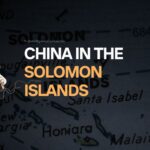The People’s Liberation Army-Navy’ (PLAN) “Type-002” aircraft carrier (formerly known as “Type-001A”) has docked at Yu-lin Naval Base (southernmost tip of Hainan island) after it passed through the disputed Taiwan Strait, satellite imagery released by Maxar Technologies show. Seven J-15 carrier multirole fighters (NATO reporting name “Flanker X-2”), three Changhe Z-18 anti-submarine helicopters and one Harbin Z-9 “Haitun” utility helicopter are seen taxied on the deck. The deployment from its “birthplace” in Dalian Shipyard to the South China Sea marks a major milestone in the Type 002’s sea trails. The Type 002 was trailed by U.S. Navy and Japanese surface groups throughout its entire transit of the Taiwan strait.
Thanks to @Maxar, we know that the PLAN’s Type-001A aircraft carrier completed its transit through the #Taiwan Strait and is now docked at Yu-lin Naval Base (Hainan island, South China Sea). A mix of J-15s, Z-18s and Z-9s are taxied on deck. #Seatrails pic.twitter.com/cQWJTFMmjC
— T-Intelligence (@T_intell) November 22, 2019
TYPE 001 & 002: INDIGENOUS PRODUCTION/ RESTRICTIVE DESIGN
The Type 002 is China’s first domestically-produced aircraft carrier despite being heavily inspired by the “Liaoning” (Type 001), the only flattop currently in service with the PLAN. The “Liaoning” started as a Soviet aircraft-carrier cruiser but was scrapped halfway through development. Following the dissolution of the USSR, the half-built vessel (named “Varyag”) fell under Ukraine’s administration which put it up for sale. The People’s Republic of China (PRC) bought the “Varyag” in 1998 and completed it in the Dalian shipyard. Ever since “Liaoning” was commissioned in 2012, the PRC was drafting plans to build more and better aircraft carriers.
Both the Type-002 and the Liaoning feature a upward-curved ramp to launch fixed-wing aircraft off the bow (i.e. ski-jump). The lack of a catapult launch system limits the the PLAN’s J-15 fighters to a 4,000 pound payload (e.g. fuel, ordnance). In comparison, a U.S. Navy F/A-18E/F SuperHornet can take-off with 12,000 pounds from the USS Truman thanks to the carrier’s steam catapults. This translates into extended range and larger weapons loadout for the aircraft. The Type-001/Type-002’s ski-jumps also limits the amount and type of aircraft it can launch and recover.
TYPE-003
Aware of the Type-001/Type-002’s obsolete design, the PLAN will reportedly introduce electromagnetic launch and recovery systems (EMALS) into the Type-003, a technology pioneered by the U.S. Navy’s new class of supercarriers (Ford-class). China’s third (and second indigenously produced) aircraft carrier is currently under construction at Jiangnan shipyard outside Shanghai, satellite imagery shows. The Type-003 is expected to commence with sea trails in 2020 and will be able to accomodate a larger and more diverse carrier air wing.
Given the high-intensity rate of Chinese naval production, the PLAN is on course to close the capability gap on the U.S. Navy. Command of the South China Sea is paramount to China’s transition from a regional force to a world power. Beijing expects to field four or five combat-ready aircraft carriers by 2030.
FOR THE RECORD: The Chinese Shipbuilding Industry has started re-designating the Type-001A as Type-002 in mid-2019. According to this logic, the aircraft carrier currently in works near Shanghai becomes the Type-003.
- Russia Bombs Maternity Ward & Children’s Hospital in Mariupol As Part of Siege - 10 March 2022
- T-Intell’s OSINT Training Marks One Year Anniversary - 18 November 2021
- IS-K Never Left the Battlefield - 27 August 2021







